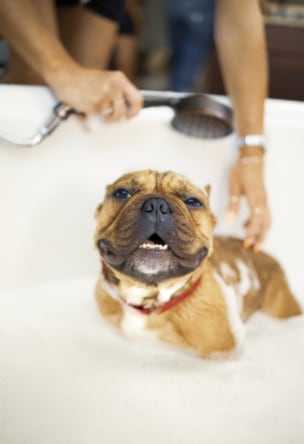Is my water safe to drink?

A definitive answer for countries as large as the United States and Canada is impossible, of course, but for the most part, yes. Nearly all public water supplies in the United States meet the US Environmental Protection Agency’s standards for safe drinking water.
What is a Boil Water Order?

A Boil Water Order is issued by public health officials when there is a concern that a disaster or other event has the potential to contaminate the water supply. Boiling your water is an effective way to ensure that your water is safe to drink. When a Boil Water Order is issued, you should make sure that any water used for drinking is boiled at least three minutes (five minutes at higher altitudes) to make sure that the water is safe. If you still have power, refrigerate the water after boiling.
Where does my drinking water come from?

There are two major sources of drinking water: surface water and groundwater. Surface water comes from lakes, reservoirs, and rivers. Groundwater comes from wells that the water supplier drills into aquifers. An aquifer is an underground geologic formation through which water flows slowly. Most large cities in the United States use surface water, and most small towns use groundwater. Some water suppliers buy treated water from others (wholesalers) and then provide water to their customers, often without further treatment.
What is the major source of water pollution?

The major source of water pollution is rain. The same rain that helps fill reservoirs, swells rivers, and makes plants, trees and crops grow washes over cattle feed lots in the Midwest, over dirty city streets, over piles of industrial waste, etc. Eventually the fallen rain, now called `runoff,’ goes directly into surface drinking water sources or seeps down through the ground into underground water sources called “aquifers,” carrying germs or chemicals - or both - with it.
How do chemicals get into my water?

Many of them, such as calcium, magnesium, iron, and others, occur naturally in water, and most of these “natural” chemicals are not harmful to your health. However, rain seeping through a hazardous waste dump eventually carries unwanted chemicals into underground sources and surface runoff pollutes reservoirs and rivers. But people are also responsible for a lot of the problem. For instance, if you paint your house with an oil-based paint, clean your brushes with paint thinner, and dump the paint thinner in the backyard, you can contaminate an aquifer that may be someone’s water supply.
Can I test my own water at home?

Not in a meaningful way. Simple kits are available to test for hardness and some chemicals like chlorine and lead, but a thorough analysis is not possible. Your local water utility can provide you with information on water quality and may test your water if you have a question or complaint. The local and state health departments can also provide water quality and testing information.
Should I buy bottled water?

You don’t need to buy bottled water for health reasons if your drinking water meets all of the federal, state, or provincial drinking water standards (ask your local supplier.) If you want a drink with a different taste, you can buy bottled water, but it costs up to 1,000 times more than municipal drinking water. Of course, in emergencies bottled water can be a vital source of drinking water for people without water. The US Food and Drug Administration (FDA) requires bottled water quality standards to be equal to those of the US Environmental Protection Agency for tap water, but the quality of the finished product is not government-monitored.
Bottlers must test their source water and finished product once a year. Currently, any bottled water that contains contaminants in excess of the allowable level is considered mislabeled unless it has a statement of substandard quality. Regulations require bottlers to inform consumers of “bottled water” contents. Although recent tests have not found any lead in dozens of brands of bottled water, studies have shown that microbes may grow in the bottles while on grocers’ shelves.
Why does my drinking water taste or smell “funny”?
Will this smelly water make me sick?

The four most common reasons for bad tasting water or smelling water care:
A noticeable taste can come from the chlorine that is added to the water to kill germs. Heavily chlorinated water may
contain “reaction products.” These products cause no taste and odor and are limited by the US Environmental Protection Agency’s rules.
A rotten-egg odor in some groundwater is caused by a non-toxic (in small amounts), smelly chemical- hydrogen sulfide - dissolved in the water.
As some algae, bacteria, and tiny fungi grow in surface water sources, they give off nontoxic, smelly chemicals that can cause unpleasant tastes in drinking water. Different algae cause different tastes and odors - grassy, swampy, and pigpen, as examples - and the little fungi can cause an earthy-musty taste.
Metallic tastes can come from copper that has dissolved from copper pipe and from iron from rusting on iron pipes. Copper can cause short-term health problems like diarrhea and cramping. Iron has no effect on health.
Water Conservation:
Water Conservation Throughout The Home
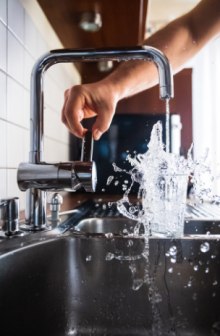
Today’s modern household uses water for myriad purposes. Everything from cleaning dishes and taking showers to doing loads of laundry and washing the car can add up to several gallons or even hundreds of gallons of water used every month. Conserving the amount of water used at home will not only help to keep your water bill lower, but it’s also better for the environment.
When you save water, you can help to reduce pollutant and contaminant runoff into natural lakes, rivers, and streams as well as extend the life of your sewer or septic system. If you’re considering a water conservation plan for your house, there are several tips and tricks you can use to reduce your water consumption. Once you make these practices a habit, you’ll be surprised at just how much water you can save.
In The Kitchen
- Only run the dishwasher with a full load. Running the dishwasher multiple times for smaller loads will cause you to use twice as much water. Dishwashers also use less water per load than it would require for you to wash them by hand.
- Don’t pre-rinse your dishes. If you have a high-quality dishwasher, it should remove food particles and stains without the need for pre-rinsing, saving excess water use.
- If you wash your dishes by hand, fill one side of the sink with fresh water and use it for rinsing when the dishes are scrubbed clean rather than rinsing each plate, cup, or utensil individually
- Install a water aerator on your kitchen faucet. An aerator allows the water pressure to remain the same but can help to reduce water use by as much as one full gallon every minute.
- Keep a large pitcher of water in the refrigerator for use whenever you need cold water. This will eliminate the need to run the sink and wait for the water to get cold.
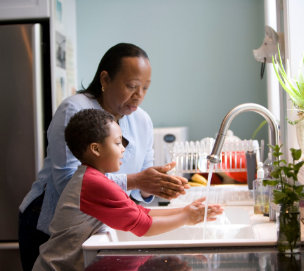
In The Bathroom
- Consider getting a low-flow shower head in your bathroom that can reduce water use every time you shower without having to sacrifice water pressure.
- Check to make sure the parts inside your toilet tank are in good shape and up to date. Worn-out fittings or chains can cause the toilet to run unnecessarily. Many new models of high-efficiency toilets work just as well without using as much water, so consider upgrading.
- Never allow the water to run while you are brushing your teeth. This can waste an excessive amount of water every time. Instead, just rinse, turn off the sink while you brush, then rinse again when you’re ready to clean off the toothbrush.
- Only fill your bathtub halfway instead of all the way to the top. Once you get in the bath, the water should rise to a comfortable level.
- Rinse razors in the sink with about one inch of water instead of rinsing them under a running stream from the faucet.
- Take shorter showers whenever possible.
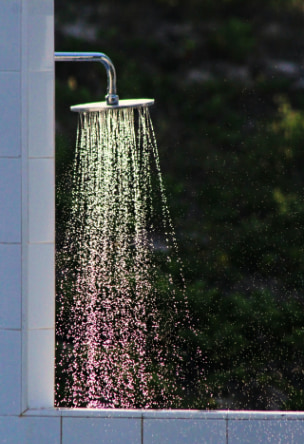
Other Indoor Water Conservation
- Check to make sure all of your pipes are properly insulated. It can take longer for water to heat up if your pipes are not insulated, which results in the water running for much longer periods of time.
- You should also cover your hot water heater with a special insulating blanket or cover.
- Look for leaks regularly throughout your home. Check under all sinks and under crawl spaces, and be sure to learn how to check and read your water meter. When in doubt, contact a professional plumber to perform regular leak checkups.
- Switch to more energy-efficient appliances, like washing machines that load from the front. Front-loading machines use much less water than top-loading washing machines and work just as well to get your clothes clean.
- When you wash fresh produce, re-use that same water for your houseplants rather than filling up a watering can.
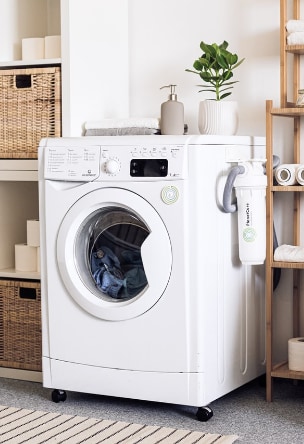
Saving Water Outside
- Water your lawn and garden as early in the morning as possible. This will prevent the water from evaporating as quickly and result in the need for less watering in general.
- Put automatic water sprinklers on a timer and make sure they are pointing only at areas where plants will be watered.
- Look for drought-resistant plants that can live throughout the year. These hardy plants often rely on their own water reserves and don’t need to be directly watered as often as other species.
- Place a layer of mulch around your flower bed and garden and under shrubs and trees. Mulch not only looks nice, but it also helps keep water from evaporating as quickly and ensures that the water is getting down to the roots.
- When it comes to washing your car, use a bucket filled with soap and water and a sponge rather than running the hose the entire time. You can repeat this by filling the bucket with clean water when you’re ready to rinse.
- Consider using a rain barrel to catch water to help nourish your outdoor plants. These special containers harvest rain quickly and will prevent you from using a hose or sprinkler system as often.
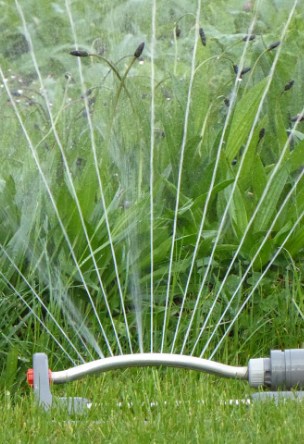
Just For Kids
- Stay away from toys that require constant running water. Instead, use a small pool to enjoy water outside, or use sports-related toys and remote-controlled devices instead.
- When washing hands, turn off the sink while kids are lathering up.
- Don’t let children flush tissues or other items down the toilet. Not only is this wasteful, but it can also cause serious plumbing problems. Encourage your kids to use a wastebasket for tissues and other everyday essentials they may be tempted to flush.
- If your children have fish, re-use the water from the tank to provide nourishment to your houseplants instead of pouring it down the drain.
- When washing the dog, make sure you wash them on an area of the lawn that needs water so you can accomplish two tasks at once. Just be sure the soap you use is safe for plants.
- Teach children to always turn the faucets off tightly to avoid drips and unnecessary water waste.
